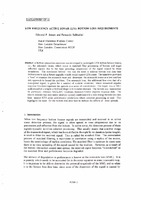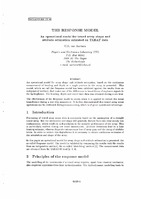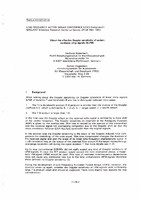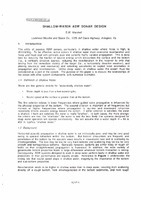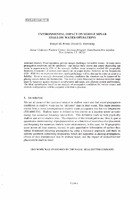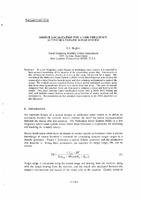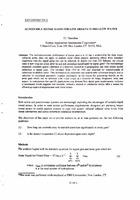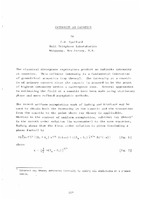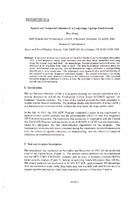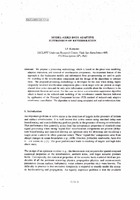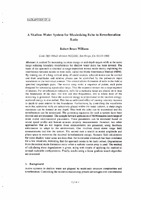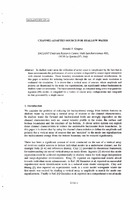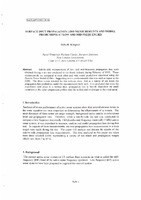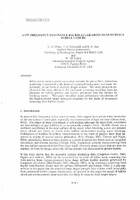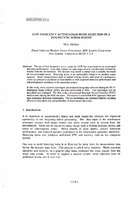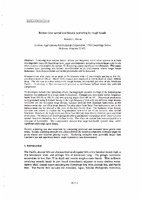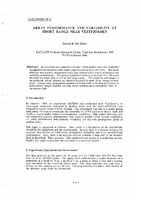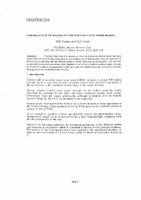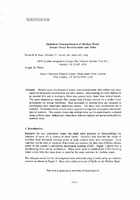Reprints: Recent submissions
Now showing items 421-440 of 548
-
Low frequency active sonar (LFA) bottom loss requirements
(NATO. SACLANTCEN, 1993/08)A bottom interaction simulator was developed to investigate LFA bottom bounce losses, i.e., the mismatch losses, which occur in matched filter processing of bottom and target reflected signals due to the time spreading ... -
The Response model: an operational model for towed array shape and attitude estimation validated on TABAT data
(NATO. SACLANTCEN, 1993/08)An operational model for array shape and attitude estimation, based on the continuous measurement of heading and depth at a single position in the array, is presented. This model, which we call the Response model has been ... -
About the effective Doppler sensitivity of certain nonlinear chirp signals (NLFM)
(NATO. SACLANTCEN, 1993/08) -
Shallow-water ASW sonar design
(NATO. SACLANTCEN, 1993/08) -
Environmental impact on mobile sonar shallow water operations
(NATO. SACLANTCEN, 1993/08)Shallow Water operations provide unique challenges for mobile sonars. In many cases propagation conditions can be optimized - our studies have shown that sound channeling can occur in approximately 75% of the strategic ... -
Source localization for a low frequency active multistatic sonar system
(NATO. SACLANTCEN, 1993/08)In a low frequency active bistatic or multistatic sonar system, it is essential tohave accurate knowledge of the location of the transmitting source ship. Inaccuracies inthis information translate directly to errors in the ... -
Achievable signal gains for line arrays in shallow water
(NATO. SACLANTCEN, 1993/08)The well-documented conformance of signal gain to a 20 log n relationship for deep water, refracted paths, does not apply to shallow water where angular spreading effects from boundary roughness limit the signal gains that ... -
Intensity at caustics
(NATO. SACLANTCEN, 1971/12)The classical divergence expressions predict an infinite intensity at caustics. This infinite intensity is a fundamental limitation of geometrical acoustics (ray theory). The intensity at a caustic is of primary concern ... -
Spatial and temporal coherence in a long range, upslope environment
(NATO. SACLANTCEN, 1993/08)In an active acoustic test conducted off the USA Pacific Coast in November-December 1991, a low-frequency source, kept stationary over the deep basin, insonified from long range the coastal slope and shelf. An autonomous, ... -
Model-aided data adaptive suppression of reverberation
(NATO. SACLANTCEN, 1993/08)We propose a processing methodology which is based on the piece-wise modeling, adaptive estimation, and removal of reverberation components. An important feature of this approach is that backscatter models and information ... -
A shallow water system for maximizing echo to reverberation ratio
(NATO. SACLANTCEN, 1993/08)A method for increasing incident energy on mid-depth targets while at the same range reducing boundary reverberation for shallow water ducts has been devised. The basis of the approach is couched in range dependant normal ... -
Channel-adapted source for shallow water
(NATO. SACLANTCEN, 1993/08)In shallow water areas the utilization of active sonar is complicated by the fact that in these environments the performance of active systems is degraded by source signal interaction with channel boundaries. These boundary ... -
Surface duct propagation loss measurements and model predictions at low and mid frequencies
(NATO. SACLANTCEN, 1993/08)Side-by-side measurements of low- and mid-frequency propagation loss were obtained during a sea test conducted in the North Atlantic during February of 1992. These measurements are compared to each other and with model ... -
Low frequency resonance backscatter from near-surface bubble clouds
(NATO. SACLANTCEN, 1993/08)When active sonar systems are used to insonate the sea surface, anomalous scattering is observed in the form of enhanced backscatter, and more importantly, in the form of discrete, bright echoes. The most plausible explanation ... -
Low frequency active sonar noise rejection in a multistatic sonar system
(NATO. SACLANTCEN, 1993/08)The use of low frequency active sonar for ASW has repercussions on automated detection performance. Input data contain not only target returns, but also noise formed by returns from the environment The detector may report ... -
A theoretical method for the prediction of underwater explosion pulses at caustics
(NATO. SACLANTCEN, 1971/12)Our concern [Refs. 1 and 2J is with the effect of refraction on the long range propagation of underwater explosion shock waves. Here, as with acoustic sources, ray tracing can be used to predict refraction effects. From ... -
Bottom time spread and bistatic scattering by rough basalt
(NATO. SACLANTCEN, 1993/08)Scattering from oceanic basalt affects low-frequency active sonar systems in at least two important ways: (1) Significant time, angle and frequency spreading reduces target echo levels when systems over-resolve the spread; ... -
Array performance and variability at short range near Vestfjorden
(NATO. SACLANTCEN, 1993/08)An experiment was conducted in October 1989 in shallow water near Vestfjorden in support of low frequency active sonar system research at SACLANTCEN. This report addresses some acoustic measurement results from that test ... -
Correlation of backscatter with bottom topography
(NATO. SACLANTCEN, 1993/08)Practical data from low frequency sonar operations in shallow water has been analysed to demonstrate that a high degree of correlation exists between the received signal due to bottom hackscattering and the hottom gradient ... -
Statistical characterization of shallow-water bistatic sonar reverberation and noise
(NATO. SACLANTCEN, 1993/08)Shallow-water, low-frequency bistatic sonar measurements often exhibit high noise caused by bathymetric reverberation and other sources. Understanding the noise statistics is an essential first step in developing filters ...
